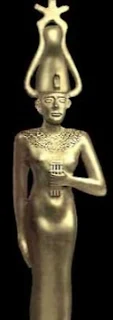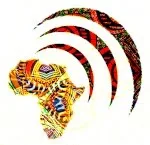Egyptian Goddess Sothis Bringer of the Nile Flood
Goddess Sothis is the daughter of Osiris, the star Sirius, bringer of the new agricultural year Nile flooding and protector of the dead.
 |
| Sothis also known as Sopdet or Sirius |
Sothis also known as Sopdet or Sirius is an ancient Egyptian goddess who was associated with the star Sirius, which was considered to be a manifestation of the goddess herself. The appearance of Sirius in the sky was seen as an important astronomical event that marked the beginning of the annual flooding of the Nile River, which was vital to the agriculture and economy of ancient Egypt.
Sothis was often depicted as a woman wearing a headdress in the shape of a star or as a seated cow, which was a symbol of fertility and nurturing. She was closely associated with the goddess Isis and was sometimes identified with her. Sothis was also believed to be the mother of the god Horus, who was seen as the protector of the pharaohs and the divine embodiment of kingship.
In Egyptian mythology, Sothis was also associated with the afterlife and was believed to guide the souls of the dead through the underworld to the afterlife. Her role as a guide and protector of the dead is reflected in the funerary texts and rituals of ancient Egypt, which often refer to her as a powerful and benevolent goddess who watches over the souls of the departed.
Sothis was worshiped throughout ancient Egypt, but her cult was particularly prominent in the city of Memphis, where a temple dedicated to her was built during the Old Kingdom period. Her worship was also closely tied to the annual flooding of the Nile River and was celebrated with festivals and ceremonies throughout the country.
Sothis, for the ancient Egyptians is a very important star that signaled the coming annual inundation of the Nile River that marked the beginning of the new agricultural year. Its bright appearance in the morning sky announced the annual flooding of the Nile.
Sothis is known also as the goddess who is the bringer of the New Year and the Nile flood. The Nile is the longest river in the world. Its main branch, called the White Nile, flows north from Lake Victoria in east-central Africa 3,470 miles to the Mediterranean Sea on Egypt’s northern border.
Starting in Ethiopia, another river, called the Blue Nile, joins the White Nile at Khartoum, Sudan, where the rivers merge and flow into Egypt. The Nile is the heart and life of the Egyptians. Although Egypt was enormous, most of the population lived near the banks of the river worshiping Sothis.
 |
| Sothis daughter of Osiris |
Pyramid Text Utterance 442:822 states, “Your third is Sothis of the pure places, she is your leader by the beautiful ways in heaven, in the Marsh of Reeds.”
It was the Nile River swollen by heavy rains that caused the river to rise and each year the Nile overflowed its banks, depositing fresh, rich topsoil on the flat plains that spread to either side of the river and enabling Egypt to grow an abundance of crops.
Erstwhile ancient civilizations had to rely on their unpredictable rainfall to water crops, and often there was too much or too little. Egypt’s great fortune was to have a river that renewed the topsoil annually and flowed in sufficient volume to water the fields.
Pyramid Text Utterance 442:965 describes Sothis as the daughter of Osiris. Therefore, Sopdet became associated with the prosperity resulting from the fertile silt left by the receding waters.
Sothis is almost always shown as a woman wearing a tall crown similar to the White Crown of Upper Egypt but with tall, upswept horns at the sides and surmounted by a star with five points.
Pyramid Text Utterance 477:965 states "It is Sothis, thy daughter, who loves thee, who secures thy livelihood, in this her name, who conducts N., when N. comes to thee."
Together we build awareness that boost harmony, education, and success, below are more links to articles you will find thought provoking.
- Historical African Country Name
- Top 20 Largest Countries in Africa
- How many countries does Africa have?
- Roots of Africanized Christianity Spiritual Songs
- Paying Money To Tour Slums in Africa
- Awesome Kenyan Woman
- Land is Not For Women in Sierra Leone
- African Kente Cloth Facts
- Accra the Ghanaian Capital Ultimate Mall Experience

 Since 2007
Since 2007


